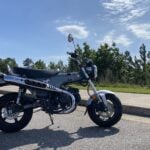For most of my riding years, I’ve been your typical “leather & denim biker” kind of guy. Even when I began to ride track days, I utilize a leather one-piece race suit. I own a couple of “old school” style leather jackets, a denim one, as well as both leather and denim chaps and pants, a couple of which have armor built in (see our “Diamond Gusset Jeans” article for my personal fave). The quintessential biker black and blue. In gear, not bruising, I might add.
Until fairly recently, I’d never really given much thought to textile gear. I assumed “Iron Butts”, ADV riders and old guys rolled in textiles. But at a motorcycling convention some 10 years ago, I witnessed a demonstration of the construction, features and versatility of modern nylon, polyester, and Cordura textile jackets and pants, and was enlightened, I must say. I left there having purchased a Texport armored riding jacket with a zip-out insulated liner. The jacket, manufactured by a company headquartered in Salzburg, Austria, has served me well in the years since, becoming my go-to “threads” for both extreme cold and summer heat. I still love my leather gear, but I’m a nylon convert as well. Can’t a guy have it all?
The textile explosion in moto gear can arguably be traced back to Aerostich, and their Roadcrafter series of riding suits. In the decades since, the quality, features, styles and companies offering textile riding garments have dramatically expanded, and today’s high tech gear is nothing short of astounding. The fabrics are manufactured to the highest standards, are very resistant to abrasion, and are available as breathable, water-resistant, moisture-wicking, UV-protected, the list goes on. Quite often, the materials woven into today’s modern gear offer as good or better protection than standard leather and denim materials.
Many if not most nylon, polyester, and Cordura garments contain CE-approved armor panels built into the gear as well, specifically in the shoulders, elbows, knees, hips and back. CE is actually a quality rating developed some years back in the European Union, to set a uniform standard of riding garments’ impact cushioning, shock absorption, and in some cases, penetration resistance. A CE-rated riding garment will clearly offer you better protection than some cheap off-the-rack, no-name brand you might be tempted to buy. Remember- dress for the slide, not just the ride.
I really like the advancements in ventilated gear, in textile, leather, and denim varieties. My nylon mesh Texport jacket has a full zip-out liner, and when held up to the light sans the liner, the light filters through the mesh around the armor panels. Now I acknowledge, mesh textiles can tear or burn against a pipe a bit more easily than fully lined, solid gear, which is why they are not advisable for track days or racing. But for casual riding, I find my mesh jacket quite suited for the hot, humid, stifling summers here in the Deep South. Textile gear can be washed, the armor can usually be easily removed for cleaning or replacing, and tend to be lighter while still woven tightly enough to give admirable impact resistance. The higher the denier rating, the heavier the strands that comprise the fabric, something I’ve recently learned.
So which is better? Leather, denim, or textile? As evidenced in the two photos above, my friends Lyle & Jimmy, and me with my dad, are sporting both textile and leather jackets with denim jeans, mine being armored. Denim is the least abrasion-resistant, leather is the least breathable, and textile is the least repairable. Yet the advantages of textile garments edge out leather ones, at least in my estimation. I’ve ridden countless miles, hours, and roads in my nylon jacket, in heat and cold, and while I love my leathers, I tend to reach for the textile over the leather now, for most rides.
What’s your go-to garment? Share it with us in the comments section below!
Rob
































Well said. I also started as a leather-and-denim rider. My go-to for this cross-country trip I’m on is a Klim Carlsbad jacket. It kept me dry in 200 miles of constant heavy rain. Try that in a leather jacket.
So you’re currently out on a road trip! Safe travels, Marco,
My “go to” is a black Textile and Kevlar “3-season” jacket. It has a zip-out quilted liner, and vents covered by velcro strips. I also have battery-powered heated vest I can add for serious cold. (and battery powered gloves, and heated grips.) I also almost always carry a very good quality raincoat. It is large enough to fit over my jacket. So, whether rain, of if I “get caught out” in dropping temperatures, the raincoat makes a wind-proof layer to hold in the body heat and keep out the cold and/or rain.
Yes, I also have full leather… for street and one for track. But the textile is more comfortable, breathable, and pleated for easier movement.
{ I do not still have the instructions and details of construction; But I assume it is a blend of cotton and polyester exterior, with a Kevlar layer between outer and inner surfaces. }
My Summer wear is a Kevlar breathable weave.
and, of course, ALL of my gear is armored and padded..
Good array of gear, Floyd! I’ve added a Sedici Marco Mesh jacket and pants to the arsenal since this writing, great all-weather gear.
Enjoyed this read Rob, is the jacket a Cycle Gear item or an online purchase? I’m leather and denim only and should own a nylon jacket. Would really like a style that doesn’t look to much like a sport/ ninjas rider. What is the correct synonym for ninja’s anyway? It’s all about safety though and you describe the comfort features very well. Thank you brother!
The Texsport brand I don’t think makes motorcycling jackets anymore, but I actually bought that one at a Great American Motorcycle Show about 10-12 years ago. Still love the jacket, held up perfectly over the years, but I also use a Sedici Marco Mesh jacket now too that I picked up from CG in Lawrenceville.
Jackets that they have which are comparable to my old Texsport would be the Fly Racing Street Flux or the Sedici Podio jacket.